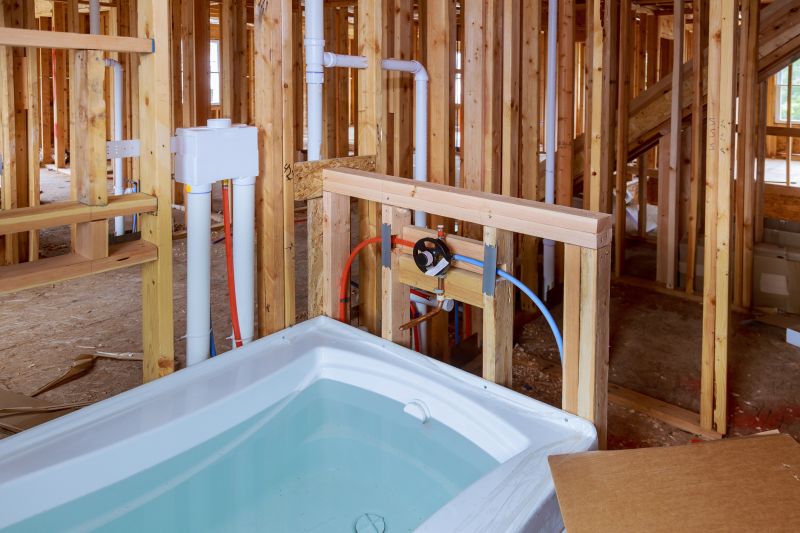Leading Bathtub Installation Products To Transform Your Bathroom
Choose from premium tools and accessories that help you create a functional and attractive bathtub area with ease.
 Installing a bathtub involves careful selection of the right products to ensure safety, durability, and proper functionality. From the initial planning stages to the final touches, choosing suitable components can make the installation process smoother and the finished product more reliable. Essential items include the bathtub itself, along with supporting hardware, plumbing fixtures, and sealing materials. Each component plays a vital role in creating a secure and functional bathing space.
Installing a bathtub involves careful selection of the right products to ensure safety, durability, and proper functionality. From the initial planning stages to the final touches, choosing suitable components can make the installation process smoother and the finished product more reliable. Essential items include the bathtub itself, along with supporting hardware, plumbing fixtures, and sealing materials. Each component plays a vital role in creating a secure and functional bathing space.
Top Overall Option
Universal Bathtub Support System
A versatile support system designed to accommodate various bathtub sizes and types, providing stability and secure installation. Its adjustable features and durable materials make it suitable for both new constructions and renovations, ensuring a reliable foundation for the bathtub. Easy to install with clear instructions, this system helps maintain proper leveling and support throughout the lifespan of the bathtub.
Types of Products For Bathtub Installations
Bathtub Surrounds and Panels
Enclosures that protect walls and add aesthetic appeal to the bathtub area, available in various materials and designs.
Bathtub Support Frames
Structural frameworks that provide stability for freestanding or drop-in tubs, ensuring proper leveling and support.
Drain Assemblies and Overflow Kits
Plumbing components essential for water drainage and overflow prevention, compatible with different tub models.
Faucets and Shower Fixtures
Variety of fixtures for filling the tub and showering, with options for different styles and functionalities.
Sealants and Caulking
Materials used to create watertight seals around the tub edges and fixtures, preventing leaks and water damage.
Anti-slip Mats and Strips
Safety accessories designed to reduce slipping hazards within the bathtub.
Grab Bars and Handrails
Assistive devices that enhance safety, especially for elderly or mobility-challenged users.
Insulation Kits
Materials that help maintain water temperature and reduce heat loss around the tub.
Tub Fillers and Diverters
Valves and mechanisms to control water flow and switch between tub and shower functions.
Support Brackets and Anchors
Hardware used to secure the bathtub to surrounding structures for added stability.
Custom-fit Bathtub Trays
Accessories that provide space for bath essentials, designed to fit specific tub models.
Waterproof Backer Boards
Installation materials that provide a moisture-resistant surface for wall surrounds.
Tub Insulation Blankets
Insulating materials that help reduce noise and heat loss during use.
Adjustable Legs and Feet
Components that allow for height adjustment and leveling of freestanding tubs.
Overflow Covers
Decorative and functional covers that prevent debris from entering the overflow drain.
Popular Choices
Stylish and versatile, these tubs can be placed anywhere with proper support and plumbing connections.
Designed to fit into a three-wall alcove, these are common in many bathroom layouts.
Maximize space by fitting into corner areas, often featuring additional seating or jets.
Deep and comfortable, ideal for relaxing baths, available in various shapes and sizes.
Hydrotherapy features that include jets for massage and relaxation, suitable for various installation types.
Vintage-style tubs that add character to traditional bathroom designs.
Designed to be installed into a custom surround or deck, offering a seamless look.
Accessible options with doors for easy entry, often used in senior or mobility-impaired bathrooms.
Lightweight and versatile, available in many shapes and sizes for various installation needs.
Heavy and durable, known for their longevity and classic appearance.
Affordable and easy to install, suitable for many standard bathroom setups.
Luxurious appearance with a sturdy feel, often used for high-end bathroom designs.
When considering bathtub installations, it's important to evaluate the space available, the type of bathtub desired, and the existing plumbing setup. Options range from traditional alcove tubs to freestanding models, each requiring specific accessories and support systems. Proper installation not only enhances the aesthetic appeal but also ensures safety and ease of maintenance over time.
Additionally, accessories such as grab bars, anti-slip mats, and custom-fit surrounds can improve safety and comfort. The selection of plumbing fixtures, including faucets, drains, and overflow covers, should align with the overall design and functional needs of the bathroom. Quality materials and compatible parts contribute to a long-lasting installation that can withstand daily use.
Whether undertaking a new build or a renovation, understanding the variety of products available for bathtub installations can help homeowners and contractors make informed decisions. Careful planning and selecting the right components can lead to a more satisfying and durable bathroom setup, all while maintaining compliance with local building codes and safety standards.
Key Buying Considerations
- Determine the available space and choose a size that fits comfortably.
- Identify the type of bathtub that best suits your needs and bathroom layout.
- Check compatibility with existing plumbing fixtures and configurations.
- Consider the material for durability, maintenance, and aesthetic appeal.
- Evaluate the weight of the tub, especially if installing in upper floors or with existing flooring constraints.
- Ensure the support system or framing is adequate for the chosen tub type.
- Review safety features such as anti-slip surfaces and grab bars.
- Select fixtures and accessories that match your overall bathroom style.
- Assess the installation complexity and whether professional help is needed.
- Verify compliance with local building codes and safety standards.
- Consider accessibility features if needed, such as walk-in doors or low thresholds.
- Check for warranty and after-sales support options.
- Estimate the overall project budget, including installation and accessories.
- Look for products with good reviews and reliable supplier reputation.
- Think about future maintenance and replacement needs.
